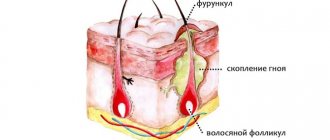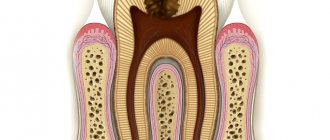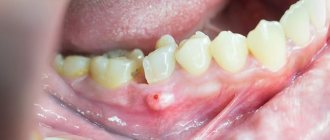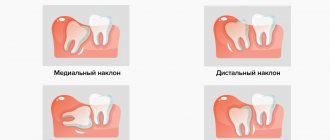From this article you will learn:
- why does flux (abscess) occur?
- abscess on the gum: treatment, antibiotics,
- opening of a gum abscess: video.
Flux on the gum is a swelling of the gums associated with the development of purulent inflammation. Dentists do not use the term gumboil or abscess (only patients say so), but use terms such as “gingival abscess” or “periostitis”.
Flux on the gum: photo
Content:
- Why does it occur
- Signs
- How it proceeds
- Features of the development of periostitis in children and adults
- What happens if you don't undergo therapy?
- How to remove flux
- How to speed up recovery
- Preventive actions
An inflammatory dental disease that affects the periosteum tissue is called periostitis by dentists.
It is popularly known as flux. It is easy to recognize on your own - a painful abscess forms on the gum, which does not go away for a long time. It is unwise to fight this disease without medical help. When it appears, you should definitely make an appointment at a dental clinic and, during an in-person examination, find out from the doctor how to remove the flux without negative consequences for health.
It is simply impossible to ignore periostitis. It is usually accompanied by acute throbbing pain. Sometimes it can even lead to fever and a sharp decrease in performance. When there is a lot of pus in the “bag”, it bursts. Then the purulent masses flow out, and the symptoms cease to be so bright.
Compresses and lotions
Compresses and lotions have an analgesic effect, limit the spread of the inflammatory process, and have a detrimental effect on pathogenic microorganisms.
Compresses with dimexide
Dimexide, when applied topically, perfectly penetrates into the inflammatory focus, inhibits the vital activity of microbes and increases their sensitivity to antibiotics. It is also able to eliminate pain. For a compress with flux, dimexide is diluted with warm water to a solution concentration of 20-30% (80 ml of liquid per 20 ml of the drug), after which a sterile napkin made of several layers of gauze is moistened with it. The compress is applied to the cheek in the affected area. The duration of the procedure is 1-2 hours. Repeat twice a day until pain and signs of inflammation are eliminated.
Before using Dimexide for the first time, it is necessary to test for an allergic reaction on the back of the elbow.
Lotions with soda
To treat gumboil, wrap a teaspoon of baking soda in several layers of gauze and place it between the cheek and gum for several hours. This will reduce swelling and relieve toothache. The lotion must be repeated 2-3 times a day.
Compress with salt
Salt has an anti-inflammatory effect, quickly relieves pain and reduces inflammation. To prepare a compress, dissolve 2-3 teaspoons of salt in 100 ml of warm water. A gauze or cotton swab is moistened with the solution and placed between the sore gum and cheek. Every 2 hours, change the compress to a new one until the acute symptoms subside.
It is better to use sea salt, which, due to the presence of iodine components, helps to relieve inflammation even better.
It is impossible to cure gumboil yourself without the participation of a dentist. Self-medication can be not only ineffective, but also dangerous. At home, you can only carry out those therapeutic procedures that have been recommended by a specialist.
Why does it occur
In order to understand how to remove flux, it is necessary to establish what led to its appearance. If the provoking factor is not eliminated, the disease may return. Among the main reasons for the violation:
- untreated deep caries;
- a large amount of hard plaque extending far under the gum;
- dental root cyst;
- inflammatory lesion of the gingival pocket;
- receiving mechanical injuries;
- general hypothermia of the body (especially against the background of reduced immunity);
- poor oral hygiene.
According to statistics, most often the disease occurs precisely because of advanced caries and pulpitis. If there is a large “hole,” the infection easily penetrates deep into the dental tissues, affects the surrounding structures and causes nerve destruction. Then pulpitis develops.
If left untreated, it will become chronic. The pain will become mild, but this does not mean that the disease has gone away. It’s just that now it’s happening secretly. The infection will continue to destroy the internal structures of the diseased unit. As they die, narcotic masses will begin to be released. To remove them, an abscess forms on the gum. This is flux.
If it is localized on the periosteum of the upper jaw, then the upper lip and the area under the eye swell. If inflammation progresses in the lower jaw, the chin and cheek swell, and the lymph nodes become painful.
What is tooth flux?
Flux, or, in dentist's language, periostitis, is a very unpleasant pathology, which is characterized by inflammation of the periosteum and soft tissues. The causes of flux on the gums can be different: trauma, gum disease, poor-quality dental treatment - all this can lead to a complication in the form of periostitis. The localization of the disease does not depend on the area of the jaw: flux of the upper and lower teeth occurs equally often.
Flux under a tooth (or above a tooth, if we are talking about the upper jaw) visually resembles an inflamed sac. However, this is far from the only possible manifestation of periostitis. There is also a serous form, when the periosteum becomes inflamed as a result of trauma and damage, as well as one of the most unpleasant types - diffuse, when the infection is localized in different parts of the jaw, which requires extensive surgical intervention with the participation of a maxillofacial surgeon.
Signs
You can understand that periostitis has developed by the following symptoms:
- tooth pain;
- swelling of the gums;
- an abscess at the base of the diseased unit;
- increased pain when pressing on the affected area;
- swelling of the cheek;
- increased body temperature;
- swelling of the lymph nodes.
If these symptoms occur, you should make an appointment with the dentist as soon as possible. In the early stages, the problem can be eliminated quite easily and quickly. Delay is fraught with health-threatening complications.
Symptoms
The clinical picture depends on factors such as the localization of inflammation and the causes of its occurrence, the body’s resistance, and the duration of the disease. Patients experience:
- redness of the mucous membrane;
- enlargement of the submandibular lymph nodes;
- deterioration of health;
- loss of appetite;
- weakness;
- temperature rise is possible.
Patients complain that not only the tooth hurts with gumboil: the painful sensations radiate to the ear, temple, and neck. In addition, swelling appears, due to which facial features lose their configuration. Depending on the location of the pain, the cheeks, upper or lower lip, chin, zygomatic and infraorbital areas swell from the flux. At the same time, the mobility of the jaw and lips is limited, and the patient has difficulty opening his mouth. The pain can be periodic: relief occurs when purulent exudate periodically pours into the oral cavity through the formed fistula.
In chronic periostitis, the symptoms are less pronounced. The pain is periodic, not severe, the contours of the face change slightly.
How it proceeds
The disease progresses through several successive stages:
- Acute serous. Spreads quickly. In just two or three days, a large, painful “bump” forms, with pus inside. The cheek tissues swell.
- Acute purulent. The pain becomes more pronounced, the person feels an unpleasant pulsation. The mucous membrane in the area of the affected unit turns red and swells. Body temperature rises.
- Acute diffuse. The swelling becomes voluminous. It can go under the eye or onto the nose. The patient's appearance changes significantly for the worse.
- Chronic. The painful process fades away and is replaced by a chronic one. The patient may mistakenly think that the problem has disappeared without a trace. In fact, it only calmed down for a while. Periodically, the disease will recur.
The sooner a sick person consults a doctor, the higher his chances of a speedy recovery.
Diagnostics
Diagnosis of flux is carried out by a general examination of the diseased tooth. Since this disease does not have a similar picture to other dental diseases, the dentist has no doubt that the patient has gumboil. Of course, additional research is being conducted to establish a holistic picture of the disease itself:
- X-ray of a diseased tooth to see the depth and size of the abscess.
- A blood test to identify the pathogen and stage of the disease.
go to top
Features of the development of periostitis in children and adults
In adults, the disease usually has vivid symptoms. Most often it is caused by bad habits and ignoring the rules of oral hygiene. The tissues surrounding the root become inflamed. Persistent pain forces a person to seek dental care.
In children, flux usually progresses with mild symptoms. This is due to the fact that in children the immune system reacts less actively to abnormal processes in the oral cavity. Even if the purulent “bump” does not hurt the child, a consultation with a dentist is still required.
Flux and abscess: causes, diagnosis, treatment methods
Flux and abscess: causes, diagnosis, treatment methods
In modern medicine, the term “flux” as such no longer exists. The once popular word has now been replaced by “odontogenic periostitis.” However, for many, the words “tooth flux” is a more understandable term and means severe pain, swelling and something serious that urgently needs to be addressed to a doctor, and rightly so.
There are different degrees of purulent inflammatory diseases of the maxillofacial area - periostitis (flux), abscess, phlegmon.
Most often they appear against the background of advanced caries.
The first stage of inflammation is periostitis (flux) of the jaw - this is an acute inflammation of the periosteum. The cause of flux is the activation of pathogenic flora: streptococci, staphylococci and other pathogenic, often putrefactive bacteria, which were in a dormant state, under certain factors begin to actively multiply and spread, triggering an acute reaction of the body aimed at eliminating the source of inflammation.
Periostitis occurs as a complication of acute or chronic, but aggravated periodontitis, which in turn appears as a result of advanced caries. Previously treated pulpitis may also be a prerequisite. Much less often, the inflammatory process can develop with difficulty in teething, injuries, as well as periodontal diseases in the presence of periodontal pockets.
Flux can also occur after tooth extraction, due to traumatic removal or incomplete extraction of roots. Sensitization and general factors play a certain role in the development of the disease: cold, overwork, stressful situations that reduce the body’s defense reactions.
Regardless of the cause, the clinical picture develops the same
Flux and its symptoms:
- constant toothache, aggravated by pressing or tapping on the tooth;
- redness and hyperemia of the gum mucosa in the area of the causative tooth
- the formation of a significant tumor in the area of the tooth, upper or lower jaw, depending on its location.
- severe pain that can only go away after taking a painkiller;
- limited mouth opening;
- signs of intoxication of the body in the form of a sharp rise in body temperature, headaches, general malaise and a feeling of chronic fatigue
Abscess – second stage of inflammation
An abscess is a purulent inflammation of tissues with their melting and the formation of a purulent cavity; functionally it is practically no different from periostitis; it forms within a day or two from the onset of the disease. The symptoms in this case are the same, but at the same time more intense. Pus, as with flux, is limited to the periosteum, but can penetrate deeper into the tissue.
Sometimes during the disease a fistulous tract may appear, through which pus will come out. An effect of imaginary well-being is created, because along with the outflow, the signs of inflammation subside. However, with this type of development, the disease becomes chronic; if the infection is not stopped, it can spread to neighboring tissues and cause a complication in the form of osteomyelitis (necrotizing inflammation of the bone).
If the abscess was not drained and the fistula never formed, purulent inflammation begins to spread to the surrounding tissues - phlegmon appears.
Phlegmon is a dangerous omission
Cellulitis is the third, most severe stage of purulent inflammation in the tissues around the tooth. In this case, the pus is not limited to the periosteum alone, but wanders freely through the tissues.
Further spread of the infectious-inflammatory process in the perimaxillary soft tissues usually occurs along the fiber of the interfascial and intermuscular spaces, the fiber surrounding the vessels, nerves, and salivary glands. In this case, tissue compaction occurs, often accompanied by the appearance of asymmetry of the face and neck in the form of swelling. The pain moves beyond the jaw and becomes less localized. Chewing function may be impaired due to pain and limited mouth opening. External breathing may be impaired, and signs of intoxication may increase.
Purulent lesions of the head and neck carry the risk of further spread of purulent infection into the facial muscles, cervical regions, and beyond them into the trachea and chest cavity, into the esophagus, into the heart, and can penetrate into the lymphatic system and brain tissue.
IMPORTANT! If phlegmon is not treated in time, it can be fatal!
Treatment of periostitis, abscess
The first and most important step in treating flux is visiting a doctor.
Treatment is complex: surgical - opening and draining the inflammation, and conservative drug therapy.
Stages of treatment:
- Examination, examination, including x-ray diagnostics, determination of indications for surgical treatment.
- Local anesthesia.
- An incision is made in the gums next to the gumboil so that the purulent contents come out, observing all the rules of asepsis and antiseptics.
- Installation of drainage for further outflow of pus - otherwise the exit from the periostitis site will close faster than it will be completely cleared.
- Removal of the affected tooth, if it is not possible to cure it, or removal of the root remaining in the hole, if we are talking about flux after removal.
- Prescription of antibiotics, anti-inflammatory, painkillers.
- Control inspection and removal of drainage.
- Recommendations for home oral care.
All procedures are performed on an outpatient basis under local anesthesia. After the examination has been carried out and the cause of inflammation has been established, an incision is first made in the area of the flux to release the accumulated pus, after which a so-called drainage - a rubber strip - is inserted into the wound. Treatment of an abscess differs from the elimination of periostitis only in the duration of wearing the drainage.
Next, the indications for tooth extraction or preservation are determined. If the tooth that was the source of infection is destroyed and has no functional or aesthetic value, then it is removed simultaneously with the opening of the abscess. This will improve the emptying of the purulent focus and will contribute to a faster elimination of inflammatory phenomena.
Tooth extraction is sometimes postponed due to perceived technical difficulties or the unsatisfactory condition of the patient.
In other cases, the tooth is preserved: its cavity is opened, the root canal is freed from decay products, and then conservative treatment of chronic periodontitis is carried out. All this is determined by the doctor and depends on the specific situation in the oral cavity. Treatment does not end there, but continues at home with the help of prescribed antibacterial and anti-inflammatory drugs. A repeat examination is scheduled on the 2nd day after surgery, the degree of subsidence of inflammatory phenomena is determined and, depending on this, additional treatment is prescribed. During dressing, local wound treatment is carried out. Around day 3-4, the drainage is removed, but conservative treatment continues.
Treatment of phlegmon is carried out in a hospital setting.
What happens after treatment?
After opening the abscess, if no complications arise, the disease enters the subacute stage. In most cases, inflammatory phenomena quickly (after 2-3 days) subside. There is a subsidence of the local inflammatory process: tissue infiltration decreases, the amount of purulent discharge from the wound decreases. As the wound is cleansed, granulation tissue appears, scarring and epithelization occur. At the same time, the severity of the general reactions of the body weakens, and health improves.
Usually, discomfort persists for the first 2 days, although the body temperature gradually begins to decrease, and the pain is no longer so obvious. A sharp improvement in condition and appearance occurs on the third day. Infiltration—tissue compaction at the site of inflammation—can persist for quite a long time. Gradually the “bump” should resolve.
The drainage - a rubber strip - should remain in the wound for some time after the procedure. It prevents the incision from closing prematurely, leaving an open path for pus to escape. It is strictly forbidden to loosen, push out, or adjust the drainage in any way. If a strip falls out, consult a doctor immediately. You should also contact your doctor if you do not feel better 12 hours after opening the flux.
The prognosis of periostitis with timely radical intervention is predominantly positive. Isolated deaths are associated with late seeking of dental care.
Self-medication of flux can lead to further spread of purulent inflammation in the tissues and such serious complications as osteomyelitis of the jaw or phlegmon of the soft tissues of the face and neck.
Prohibited for inflammation:
- try to open the abscess yourself;
- apply warm compresses and dressings;
- independently prescribe antibiotics and other medications;
- take painkillers before visiting a doctor;
- drink aspirin (before and after opening).
Finally, I would like to say one thing: please do not be afraid to consult a doctor for help in a timely manner. The sooner treatment is started, the better the outcome. Take care of yourself!
What happens if you don't undergo therapy?
It is unacceptable to treat purulent gum lesions as a minor dental disorder. It is very insidious and rarely disappears without a trace on its own. Often, if treatment is refused, the following occurs:
- Abscess. It is a consequence of a long-term presence of a pus-filled sac in the area of the tooth root. The abscess grows and then ruptures.
- Phlegmon. Represents an extended lesion. It usually occurs after a rupture of a purulent sac, if the patient does not comply with the dentist’s instructions, does not rinse the mouth with a special antiseptic solution, or apply anti-inflammatory gels.
- Osteomyelitis of the jaw. It occurs if the gums are not treated for a very long time. The pathological process spreads to the jaw bone, which is very dangerous.
- Inflammation of individual sinuses of the skull. It is also diagnosed with advanced periostitis. The maxillary, frontal and sphenoid sinuses are affected.
It is extremely rare that the disease affects brain tissue. Then the person may even die.
Consequences of untreated flux:
- abscess (abscess) - the formation of a purulent sac;
- phlegmon - an extensive inflammatory process after the rupture of an abscess;
- osteomyelitis of the jaw - inflammation of the tissues of the jaw bone;
- inflammation of the sinuses of the skull - the sphenoid, maxillary and frontal sinuses are involved in the pathological process. Sometimes the infection penetrates into the brain tissue.
Important: specialists from the “Smile” clinic network recommend starting treatment as early as possible. The faster the inflammation is stopped, the less effort will be required to eliminate the problem and restore the patient’s health.
How to remove flux
To avoid purulent damage to the pulp zone and periosteum, you need to receive qualified dental care in a timely manner. In the early stages of the disease, in order to prevent further progression of the inflammatory process, the patient is prescribed anti-inflammatory drugs and antibiotics. It is mandatory to open the abscess. The wound is then cleaned and washed with an antiseptic.
In some cases, to prevent re-accumulation of pus, drainage is installed for several days. All surgical procedures are always performed under general anesthesia so that the patient does not experience pain.
To support the patient’s body, he is additionally prescribed a vitamin and mineral complex. If necessary, physiotherapy is included in the treatment course. Good results can be obtained using UHF and electrophoresis.
It is important to strictly follow all medical recommendations and under no circumstances interrupt antibiotic therapy. Treatment is considered successfully completed if pus is no longer released, pain does not occur, and the entire wound has healed. In some cases, after healing, a small bluish scar remains on the gum. You shouldn't worry about it. This means that the defeat was very deep. Over time, the gums will return to their normal appearance.
Is a tooth removed during gumboil?
A tooth can be removed due to flux, but in modern dentistry the emphasis is on tooth-preserving manipulations. This also applies to flux. A tooth must be removed when its crown is seriously damaged and cannot be restored with a pin or inlays. If an infection occurs under the crown, then re-prosthetics are often difficult. In some cases, a tooth has to be removed because it is impossible to unfill the canals after a previous unsuccessful treatment, but this happens extremely rarely. In any case, the doctor makes the decision to remove a tooth based on the clinical picture.
How to speed up recovery
To make healing go faster, it is important not only to follow the dentist’s instructions, but also to remember the rules:
- do not heat the area where the pus was located;
- do not take antibiotics or any other medications unless prescribed by a doctor;
- do not use any folk recipes without consulting your doctor;
- Until the wound is completely healed, do not use aspirin or any medications that contain acetylsalicylic acid.
If the “bump” appears again, it is recommended to immediately contact a dental clinic.
What complications can flux cause?
The development of gumboil is a process in which treatment should not be delayed. If left unattended for a long time, flux can cause even more serious diseases that threaten not only the patient’s health, but also life.
Purulent flux can develop into such serious diseases as phlegmon, mediastenitis, osteomyelitis of the jaw and even sepsis. That is why, if a patient detects any first symptoms of flux development, he needs to immediately seek help.
Preventive actions
To reduce the likelihood of periostitis, you need to take care of your teeth and visit the dentist at least once a year. You can't start caries. As soon as a dark spot appears on the surface of the dental crown, it needs to be treated.
After eating, it is advisable to rinse your mouth with warm water. To make hygiene as high as possible, it makes sense to use not only a brush and toothpaste, but also dental floss and irrigators. It is very important to remove tartar every year at the dentist's office.
An important place in the issue of prevention is given to diet. You should eat as much fresh fruits, vegetables, and plant foods as possible. They require more thorough chewing and thus have a positive effect on the ligamentous apparatus that holds the tooth. They also provide natural cleansing of crowns from soft plaque.
If you have any questions about how to remove flux, please contact the doctors at the Line of Smile dental clinic for help. We specialize in the treatment of this disease and know how to quickly rid our patients of it.
Why is tooth flux dangerous?
An inflammatory process of this type tends to develop and, as it spreads, affects deeper layers of tissue. If left untreated, flux often develops into phlegmon - a serious purulent inflammation that has no definite boundaries. The most severe forms of flux provoke the development of sepsis, which can lead to infection of the entire body and even death. It is important not only to know how to cure gumboil and visit the dentist on time, but also to follow a number of preventive measures so that the likelihood of complications developing is minimal.
- Regular and high-quality hygiene.
- Treatment of caries at the initial stage. Flux, dental cysts and other complications often arise due to untreated pulpitis and periodontitis.
- Preventative visits to the clinic to assess the condition of the oral cavity and carry out professional cleaning.
Who had the dream
The formation of an interpretation of dreams that corresponds to reality directly depends on who dreams a particular dream. The plot of the dream is of primary importance. Today there are many dream books, among which it is difficult to choose one that suggests the correct interpretation. Therefore, it is necessary to understand this issue in detail.
To a woman
For a married woman, dental gumboil predicts the appearance of a financially secure admirer in her life, who will try to gain attention to his person. If a young girl had a dream with the same plot, for her it will mean completing an urgent project at work.
To a man
Interpretation for a married man: flux may dream of making useful acquaintances. If a man is a bachelor, then for him this means well-deserved respect from his colleagues.
Pregnant
For a pregnant woman to acquire gumboil in a dream means that the expectant mother is experiencing strong feelings about the expected baby. To eliminate causes for concern, a woman in an interesting position should check her health with her doctor, and also try to avoid negative emotions and nervous stress.
Who had gumboil in a dream?
Someone else has a similar problem with dental health - this means that in reality they are giving up good earnings in favor of a loved one.
You
If you yourself have developed dental flux, this can be interpreted as strengthening your own business reputation.
The child has
A child suffering from flux - from night visions wants to suggest that the one who is now sleeping is in danger of doing completely meaningless work.
With relatives
When you dream about a similar plot, it promises to receive a pleasant gift from a loved one.
With a spouse
If a flux appears in a dream for a husband or wife, it may mean that one of these days there will be a conflict situation with colleagues on work issues. According to the interpretation of the Islamic dream book, this is interpreted as a manifestation of some disease.
In a dream, you cannot meet your soulmate who has developed a flux - this means that in real life there is a lack of sincerity or trust in your relationship with your loved one.
At my brother's
A brother suffered from gumboil in a dream - this means that in real life you can prepare for the unexpected arrival of noisy guests.
At my sister's
A sister who gets flux in a dream signals emotional burnout of the person who saw this dream.
From a friend or girlfriend
When gumboil appears in one of your close friends’ dreams, it has a positive interpretation. This means that a person will experience career growth, that is, obtaining a higher-paying position in the near future. According to another dream interpreter, a dream prepares a person for hard and tedious work.
From a stranger
If you dream of a stranger who has such a health problem, this predicts stagnation in planned affairs. Everything that was planned for the coming week will stall and slow down. According to another meaning, such a dream promises the presentation of an expensive gift.
At the deceased's
If a deceased person suddenly develops swollen flux, this has a positive interpretation. It is worth waiting for pleasant acquisitions in reality.
What to do after removal or opening?
After opening the flux, you should not wait for the swelling to disappear immediately. Many patients feel that the flux does not go away after tooth extraction, although this is not the case at all. In some cases, the swelling may increase slightly after the procedure. Approximately on the third day after surgery, the patient should make a dramatic recovery, but the infiltration may remain for quite a long time. Within a few hours after the operation, the toothache in the area of the lesion should disappear and the body temperature should decrease.
Usually the swelling goes away only a few days after opening the purulent focus. Do not be alarmed if the swelling increases slightly after surgery.
The specialist installs a special rubber drainage in the incision, which you should never try to fix yourself. Otherwise, the recommendations are the same as for regular tooth extraction. You should not eat for several hours after the procedure. During the day, try to avoid hard and rough foods, as well as hot drinks. Regarding the use of medications in each individual case, the specialist gives individual recommendations.










